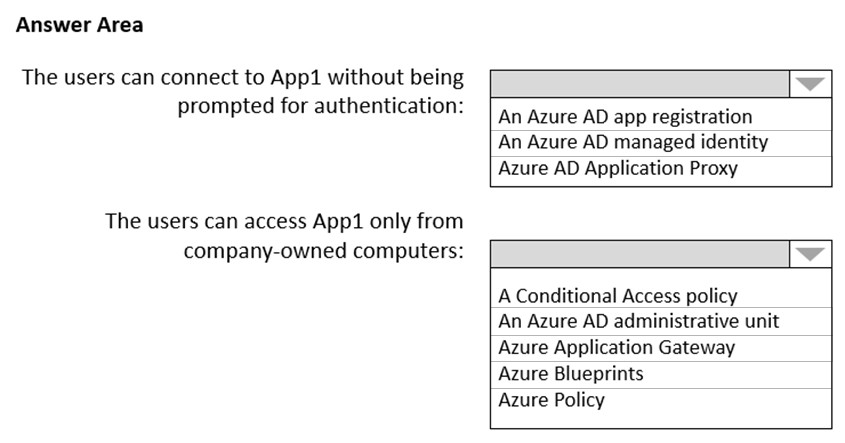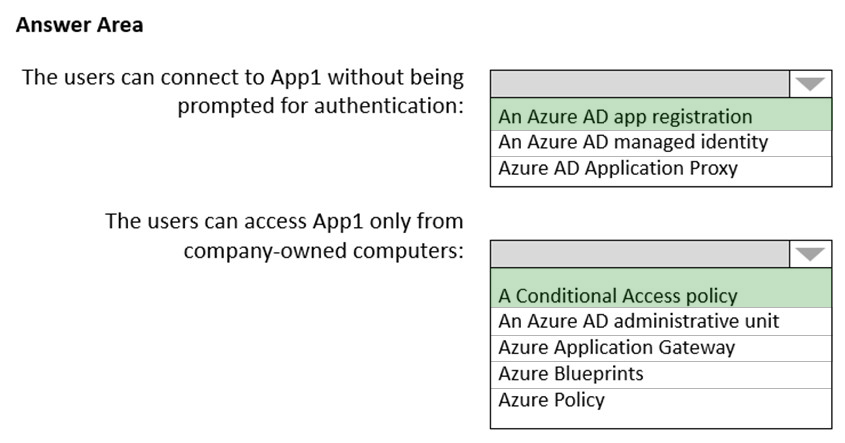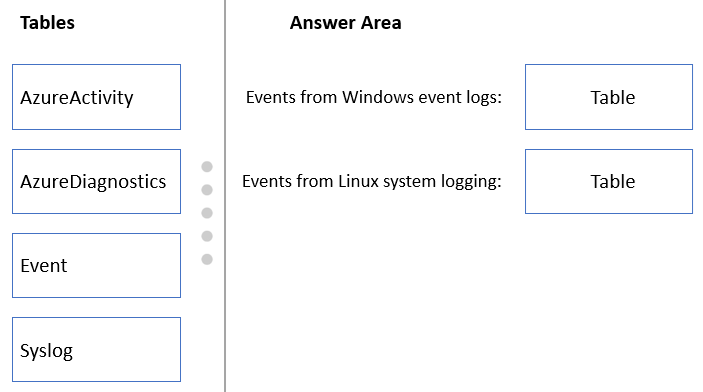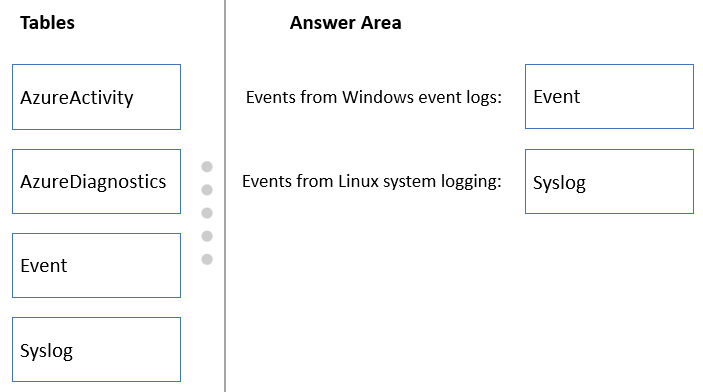HOTSPOT -
You plan to deploy an Azure web app named App1 that will use Azure Active Directory (Azure AD) authentication.
App1 will be accessed from the internet by the users at your company. All the users have computers that run Windows 10 and are joined to Azure AD.
You need to recommend a solution to ensure that the users can connect to App1 without being prompted for authentication and can access App1 only from company-owned computers.
What should you recommend for each requirement? To answer, select the appropriate options in the answer area.
NOTE: Each correct selection is worth one point.
Hot Area:
Answer:

Box 1: An Azure AD app registration
Azure active directory (AD) provides cloud based directory and identity management services.You can use azure AD to manage users of your application and authenticate access to your applications using azure active directory.
You register your application with Azure active directory tenant.
Box 2: A conditional access policy
Conditional Access policies at their simplest are if-then statements, if a user wants to access a resource, then they must complete an action.
By using Conditional Access policies, you can apply the right access controls when needed to keep your organization secure and stay out of your user's way when not needed.
Reference:
https://codingcanvas.com/using-azure-active-directory-authentication-in-your-web-application/ https://docs.microsoft.com/en-us/azure/active-directory/conditional-access/overview
Note: This question is part of a series of questions that present the same scenario. Each question in the series contains a unique solution that might meet the stated goals. Some question sets might have more than one correct solution, while others might not have a correct solution.
After you answer a question in this section, you will NOT be able to return to it. As a result, these questions will not appear in the review screen.
Your company deploys several virtual machines on-premises and to Azure. ExpressRoute is deployed and configured for on-premises to Azure connectivity.
Several virtual machines exhibit network connectivity issues.
You need to analyze the network traffic to identify whether packets are being allowed or denied to the virtual machines.
Solution: Use Azure Traffic Analytics in Azure Network Watcher to analyze the network traffic.
Does this meet the goal?
Answer:
B
Instead use Azure Network Watcher IP Flow Verify, which allows you to detect traffic filtering issues at a VM level.
Note: IP flow verify checks if a packet is allowed or denied to or from a virtual machine. The information consists of direction, protocol, local IP, remote IP, local port, and remote port. If the packet is denied by a security group, the name of the rule that denied the packet is returned. While any source or destination IP can be chosen, IP flow verify helps administrators quickly diagnose connectivity issues from or to the internet and from or to the on-premises environment.
Reference:
https://docs.microsoft.com/en-us/azure/network-watcher/network-watcher-ip-flow-verify-overview
Note: This question is part of a series of questions that present the same scenario. Each question in the series contains a unique solution that might meet the stated goals. Some question sets might have more than one correct solution, while others might not have a correct solution.
After you answer a question in this section, you will NOT be able to return to it. As a result, these questions will not appear in the review screen.
Your company deploys several virtual machines on-premises and to Azure. ExpressRoute is deployed and configured for on-premises to Azure connectivity.
Several virtual machines exhibit network connectivity issues.
You need to analyze the network traffic to identify whether packets are being allowed or denied to the virtual machines.
Solution: Use Azure Advisor to analyze the network traffic.
Does this meet the goal?
Answer:
B
Instead use Azure Network Watcher IP Flow Verify, which allows you to detect traffic filtering issues at a VM level.
Note: IP flow verify checks if a packet is allowed or denied to or from a virtual machine. The information consists of direction, protocol, local IP, remote IP, local port, and remote port. If the packet is denied by a security group, the name of the rule that denied the packet is returned. While any source or destination IP can be chosen, IP flow verify helps administrators quickly diagnose connectivity issues from or to the internet and from or to the on-premises environment.
Reference:
https://docs.microsoft.com/en-us/azure/network-watcher/network-watcher-ip-flow-verify-overview
Note: This question is part of a series of questions that present the same scenario. Each question in the series contains a unique solution that might meet the stated goals. Some question sets might have more than one correct solution, while others might not have a correct solution.
After you answer a question in this section, you will NOT be able to return to it. As a result, these questions will not appear in the review screen.
Your company deploys several virtual machines on-premises and to Azure. ExpressRoute is deployed and configured for on-premises to Azure connectivity.
Several virtual machines exhibit network connectivity issues.
You need to analyze the network traffic to identify whether packets are being allowed or denied to the virtual machines.
Solution: Use Azure Network Watcher to run IP flow verify to analyze the network traffic.
Does this meet the goal?
Answer:
A
Azure Network Watcher IP Flow Verify allows you to detect traffic filtering issues at a VM level.
IP flow verify checks if a packet is allowed or denied to or from a virtual machine. The information consists of direction, protocol, local IP, remote IP, local port, and remote port. If the packet is denied by a security group, the name of the rule that denied the packet is returned. While any source or destination IP can be chosen,
IP flow verify helps administrators quickly diagnose connectivity issues from or to the internet and from or to the on-premises environment.
Reference:
https://docs.microsoft.com/en-us/azure/network-watcher/network-watcher-ip-flow-verify-overview
DRAG DROP -
You have an Azure subscription. The subscription contains Azure virtual machines that run Windows Server 2016 and Linux.
You need to use Azure Monitor to design an alerting strategy for security-related events.
Which Azure Monitor Logs tables should you query? To answer, drag the appropriate tables to the correct log types. Each table may be used once, more than once, or not at all. You may need to drag the split bar between panes or scroll to view content.
NOTE: Each correct selection is worth one point.
Select and Place:
Answer:

Reference:
https://docs.microsoft.com/en-us/azure/azure-monitor/platform/data-sources-windows-events https://docs.microsoft.com/en-us/azure/azure-monitor/agents/data-sources-syslog
Note: This question is part of a series of questions that present the same scenario. Each question in the series contains a unique solution that might meet the stated goals. Some question sets might have more than one correct solution, while others might not have a correct solution.
After you answer a question in this section, you will NOT be able to return to it. As a result, these questions will not appear in the review screen.
You need to deploy resources to host a stateless web app in an Azure subscription. The solution must meet the following requirements:
✑ Provide access to the full .NET framework.
✑ Provide redundancy if an Azure region fails.
✑ Grant administrators access to the operating system to install custom application dependencies.
Solution: You deploy a web app in an Isolated App Service plan.
Does this meet the goal?
Answer:
B
Instead: You deploy two Azure virtual machines to two Azure regions, and you create an Azure Traffic Manager profile.
Note: Azure Traffic Manager is a DNS-based traffic load balancer that enables you to distribute traffic optimally to services across global Azure regions, while providing high availability and responsiveness.
Reference:
https://docs.microsoft.com/en-us/azure/traffic-manager/traffic-manager-overview
You need to design a highly available Azure SQL database that meets the following requirements:
✑ Failover between replicas of the database must occur without any data loss.
✑ The database must remain available in the event of a zone outage.
✑ Costs must be minimized.
Which deployment option should you use?
Answer:
A
Now your new and existing serverless Azure SQL Databases allow for zone redundant configuration. This feature utilizes Azure Availability Zones to replicate databases across multiple physical locations within an Azure region. By selecting zone redundancy, you can make your serverless databases resilient to a much larger set of failures, including catastrophic datacenter outagesג€"without any changes of the application logic.
The SQL Database serverless compute tier optimizes price-performance and simplifies performance management for single databases with intermittent, unpredictable usage by auto-scaling compute and billing for compute used per second.
Incorrect:
Not B: Azure SQL Database Business Critical is a more expensive solution.
Not C: Azure SQL Database Basic does not provide zone redundancy.
Not D: Azure SQL Database Standard is a more expensive solution.
Reference:
https://azure.microsoft.com/en-us/updates/public-preview-zone-redundant-configuration-for-azure-sql-database-serverless-compute-tier/
HOTSPOT
-
You have an on-premises Microsoft SQL Server database named SQL1.
You plan to migrate SQL1 to Azure.
You need to recommend a hosting solution for SQL1. The solution must meet the following requirements:
• Support the deployment of multiple secondary, read-only replicas.
• Support automatic replication between primary and secondary replicas.
• Support failover between primary and secondary replicas within a 15-minute recovery time objective (RTO).
What should you include in the solution? To answer, select the appropriate options in the answer area.
NOTE: Each correct selection is worth one point.
Answer:

HOTSPOT
-
You have two on-premises Microsoft SQL Server 2017 instances that host an Always On availability group named AG1. AG1 contains a single database named DB1.
You have an Azure subscription that contains a virtual machine named VM1. VM1 runs Linux and contains a SQL Server 2019 instance.
You need to migrate DB1 to VM1. The solution must minimize downtime on DB1.
What should you do? To answer, select the appropriate options in the answer area.
NOTE: Each correct selection is worth one point.
Answer:

HOTSPOT
-
You are building an Azure web app that will store the Personally Identifiable Information (PII) of employees.
You need to recommend an Azure SQL. Database solution for the web app. The solution must meet the following requirements:
• Maintain availability in the event of a single datacenter outage.
• Support the encryption of specific columns that contain PII.
• Automatically scale up during payroll operations.
• Minimize costs.
What should you include in the recommendations? To answer, select the appropriate options in the answer area.
NOTE: Each correct selection is worth one point.
Answer:
